 Leisure and Cultural Services Department - Healthy Exercise for All CampaignLeisure and Cultural Services Department
Leisure and Cultural Services Department - Healthy Exercise for All CampaignLeisure and Cultural Services Department
QualiWalk
Introduction
“Daily exercise keeps us fit People of all ages can do it”
An accumulation of at least 30 minutes of moderate-intensity aerobic physical activity (at least 10 minutes per session) can bring great benefits to your health.
Walking is perhaps the safest and most effective aerobic physical activity. Easy to master and good for health, it can be done at any time. Walking with your family members and friends helps maintain good relationships as well. A walking exercise that is performed with correct posture and in proper amount is called QualiWalk (Fitness Walking). It does not require much gear beyond a pair of good walking shoes to protect your feet. To enjoy an energetic and healthy life, take your first step in walking now.
Benefits of Walking
- Improving your blood circulation and cardiopulmonary function
- To maintain physical fitness and boost self-confidence
- To burn energy and keep a healthy body weight
- Keeping the levels of blood pressure, blood lipids, cholesterol and blood glucose under control, as well as reducing the risk of cardiovascular disease, hypertension and diabetes, and preventing some types of cancer (e.g. colorectal cancer)
- Strengthening your bones, muscles and joints, and preventing osteoporosis
- Relieving stress, and enhancing mental alertness and memory
- Improving the physical strength, mobility and balance control of the elderly
- Improving the fitness level of pregnant and post-natal women
The Posture, Techniques and Pace of Walking
|
Posture
|
 |
|
|
Proper Techniques
- Relax and do not tense your muscles.
- When your foot touches the ground, use your heel first, then feel the pressure roll toward the front part of your foot and toes. When moving your feet alternately, shift your body weight from one leg to the other.
- Walk naturally in larger-than-usual strides of about 0.5 m to 0.75 m, depending on your body size.
- Co-ordinate upper and lower body movements and swing your arms naturally.
- Keep your feet parallel when moving forward, do not put one foot in front of the other in a straight line like catwalk models.

Correct Pace
- Start with a shorter distance and increase the distance gradually.
- Walk at a pace that gradually increases your breathing and heart rates.
- Adjust your breathing according to the intensity of the walk. If you are walking at the right pace, you should be breathing faster than usual but still be able to carry on a conversation comfortably.
- For a more vigorous walk, move in larger strides at a higher frequency while keeping your posture, breathing and symmetry of movement unaffected.
- As the walking pace increases, you swing your arms more.
- Start with flat ground.
Relationship between Walking and Energy Expenditure
Method 1: By Walking Distance

| Smart Tips: “Virtual Classroom -- Energy Expenditure” provides a rough estimate of our daily energy expenditure and encourages us to manage our body weight by participating in physical activities and building them into our daily life. Games:http://www.lcsd.gov.hk/healthy/en/game_sport_classroom_01.php |
Method 2: By Step Count
Please check the energy cost with reference to your body weight and total step count in the chart below.

| (Note: |
The information shown above is for general reference only. The actual situation may vary with the age, gender, physical fitness, skill level and intensity of the exercise of an individual.)
|
| Smart Tips: Walk 10 000 steps a day! The number of steps walked per day varies with occupation and life pattern. Generally speaking, it is recommended that 8 000 to 10 000 steps should be taken every day for improvement of physical fitness. You can keep track of the number of steps you walk in your daily life by using a pedometer or relevant mobile applications. |
Walking Exercise Prescription
Walking is a physical activity suitable for people of all ages. Regular walking can effectively improve cardiopulmonary function and cardiorespiratory endurance. You should develop a practice plan according to your health condition and physical fitness. The normal pattern should be 3 to 5 times a week for at least 30 minutes each time. Beginners can start with sessions of at least 10 minutes each depending on their physical fitness.
- Frequency: Exercise 3 to 5 times a week and have enough rest after exercise.
- Intensity: You may vary the intensity of exercise by adjusting your pace and stride. To assess the exercise intensity, you may make use of the Rating of Perceived Exertion and the Target Heart Rate Zone.
- Time: You can start with a 30-minute walk at the beginner stage, which may be divided into sessions of at least 10 minutes each. The duration can then be gradually increased according to your physical ability.
Monitoring of Exercise Intensity

RPE may be used to monitor and assess the level of exercise intensity. RPE between 5 to 7 is recommended for most people, subject to downward adjustment according to individual's need and physical fitness.

*Note: Chronic patients and those who do not have the habit of doing exercise should adjust the upper limit to 70% and consult their doctors first to workout a safe exercise programme.
| Smart Tips: How to Measure Heart Rate
|
 |
| Smart Tips: Let's Plan our Intensity of Physical Activity Walking is an aerobic exercise. Regular walking will not only improve health indexes, but also enhance physical fitness. Initially, you should start with aerobic exercise of moderate-intensity before proceeding gradually to exercise of vigorous-intensity. To monitor your progress from moderate- to vigorous-intensity, you can measure your heart rate against the target heart rate. Games:http://www.lcsd.gov.hk/healthy/en/game_sport_level_01.php |
Exercise Procedure
| Procedure | Physical Activity | Duration | Purpose | ||
|---|---|---|---|---|---|
| Warm-up | Warm-up exercise of low-intensity | At least 5 minutes |
|
||
| Stretching exercises | At least 10 minutes | ||||
| Workout | Walking exercise of a moderate- to vigorous-intensity, coupled with a suitable amount of resistance training | At least 30 minutes |
|
||
| Cool-down | Stretching exercises | At least 10 minutes |
|
||
| Cool-down exercises of low intensity | At least 5 minutes |
In cold weather, spend more time on warm-up exercises of higher intensity and wear appropriate warm clothing to maintain your body temperature.
Stretching Exercises
Basic principles:
- Do static stretching exercises.
- Do not overstretch your muscles, and avoid sudden or jerky movements and ballistic stretching exercises.
- Slightly stretch your muscles for 10 to 30 seconds, and keep your breathing even and smooth.
- Do stretching exercises from head to toe or vice versa.
- Stretch your muscles and joints on both sides of your body evenly, repeat 3 to 4 times each side.
Demonstration of stretching exercises:
| 1 | Neck  |
|
||
| 2 | Shoulders and neck  |
|
||
| 3 | Shoulders  |
|
||
| 4 | Arms |
|
||
| 5 | Chest  |
|
||
| 6 | Waist |
|
||
| 7 | Anterior thighs |
|
||
| 8 | Inner thighs  |
|
||
| 9 | Posterior thighs |
|
||
| 10 | Calves |
|
Resistance Training
Basic principles
- Wear loose outfits. Do warm-up stretching exercises before resistance training.
- Resistance training should be progressive in nature, so that muscular strength and endurance can be improved in a safe and effective way.
- Resistance training is best performed 2 to 3 days per week, targeting major muscle groups of the body, including chest, shoulders, upper back, waist and back, abdomen, buttocks, thighs and calves.
- In each training session, perform 2 to 4 sets of training for each major muscle group and perform 10 to 15 repetitions for each set.
- Keep your breathing even and smooth during the exercise. Exhale when exerting force for pulling or pushing, and inhale slowly when returning to original positions. Do not hold your breath to avoid adverse effects on the cardiovascular system.
- After each training session, do stretching exercises to let your body cool down and adjust.
- Professional supervision is required for all the resistance training during recovery from illness or injury, and in the case of joint pain or pregnancy.
Demonstration of Resistance Training
| Smart Tips: Resistance training is a muscle strengthening exercise that is effective in improving muscular strength and endurance, toning muscles and strengthening joints |
| 1. | 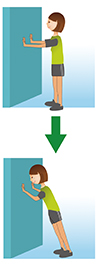 |
Wall Press Up (chest, shoulders and posterior arms)
|
| 2. | 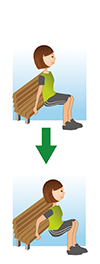 |
Dipping (chest, shoulders and posterior arms)
|
| 3. | 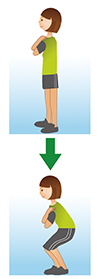 |
Squat (thighs and hips)
|
| 4. | 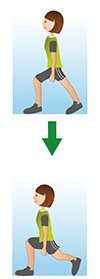 |
Lunge (thighs and hips)
|
| 5. |  |
Stepping (thighs and hips)
|
| Smart Tips : Lifting a water bottle can strengthen your muscles in a leisurely manner. Stand erect with your feet shoulder-width apart and slightly bent. Hold a plastic bottle containing about 500 ml of water with your right hand. Raise your right arm and keep it straight. Return slowly to the starting position. Repeat 10 to 15 times with each arm. |
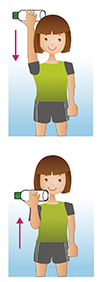 |
Cardiorespiratory Endurance Test
In the QualiWalk training class held by the Leisure and Cultural Services Department (LCSD), the instructors will arrange for a 1 mile (i.e. 1.6 km) walking test for the participants so as to let them have a better understanding of their physical conditions. The test is conducted in the following way:
- Select a walking trail of approximately 1.6 km (i.e. 1 mile) in length.
- Warm up first. Count the time as you start walking. Walk at the fastest pace and in a steady manner to finish the trail.
- As soon as you reach the end of the trail, record the time spent on the walk.
- Then count your pulse rate for 15 seconds. Multiply the counted rate by 4 to find out your heart rate per minute after exercise.
- Refer to the assessment comparison table * to check your physical fitness.
* Instructor will provide another table for participants aged under 20.
Assessment Comparison Table (For Male)
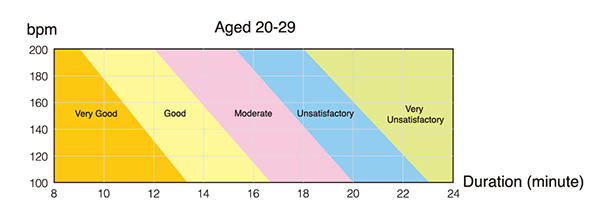


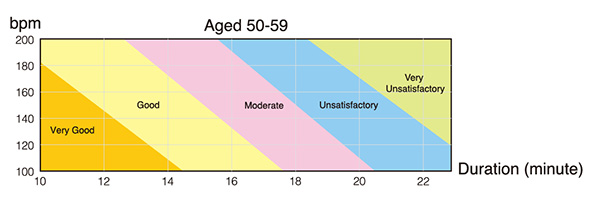

Assessment Comparison Table (For Female)
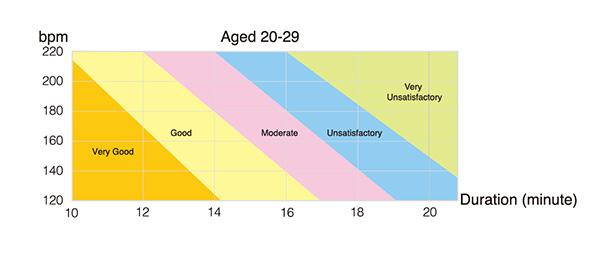
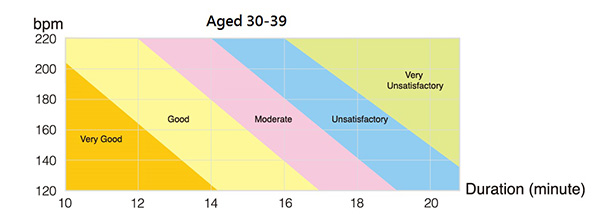
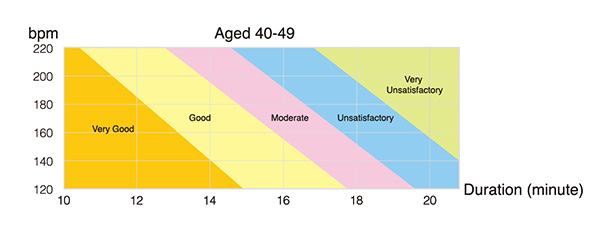
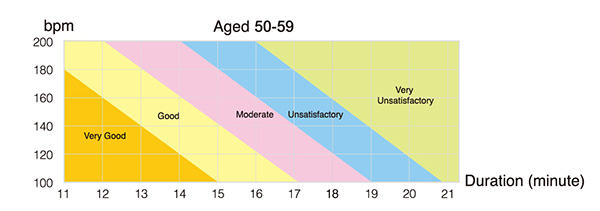
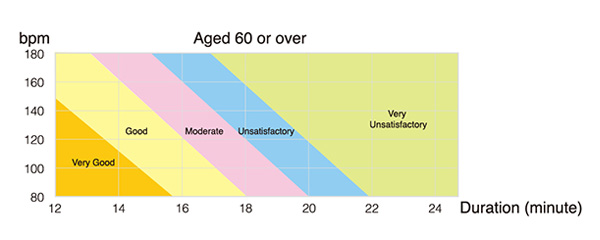
Recommended Walking Trails
What places are suitable for walking? First of all, you must select a safe trail, e.g. a well-lit trail with a dry road surface and free of obstacles. Some suitable trails are suggested below:
| District | Venue |
|---|---|
| Southern | Ap Lei Chau Wind Tower Park |
| Central and Western | Hong Kong Park |
| Sun Yat Sen Memorial Park | |
| Wan Chai | Wan Chai Park |
| Bowen Road | |
| Eastern | Quarry Bay Park |
| Sham Shui Po | Lai Chi Kok Park |
| Yau Tsim Mong | Kowloon Park |
| Wong Tai Sin | Po Kong Village Road Park |
| Ngau Chi Wan Park | |
| Kwun Tong | Laguna Park |
| Jordan Valley Park | |
| Kowloon City | Kowloon Walled City Park |
| Capenter Road Park | |
| Kowloon Tsai Park | |
| North | North District Park |
| Pak Fuk Tin Sum Playground | |
| Tai Po | Tai Po Waterfront Park |
| Mui Shue Hang Playground | |
| Sha Tin | Sha Tin Park |
| Ma On Shan Park | |
| Ma On Shan Promenade | |
| Sai Kung | Sai Kung Promende |
| Po Tsui Park | |
| Tseung Kwan O Waterfront Park | |
| Tuen Mun | Tuen Mun Park |
| Wu Shan Riverside Park | |
| Yuen Long | Yuen Long Park |
| Tin Shui Wai Park | |
| Tsuen Wan | Shing Mun Valley Park |
| Tsuen Wan Park | |
| Kwai Tsing | Tsing Yi Park |
Taking a walk regularly has long term benefits for our health. Apart from walking the trails , you may also try the following:
- walking instead of taking public transport for short journeys; getting off the vehicle one or two stops earlier and walking to your destination
- walking with your friends and have fun together
- going for a walk in the morning and evening, to get relaxed and relieve stress.
Safety Tips and Points to Note for Walking
- Understand your own physical condition (especially for persons who suffer from chronic illnesses). As health condition and physical fitness vary among individuals, it is advisable to ensure that the intensity, duration and frequency of exercise are within your capabilities.
- Make walking a habit and do it progressively according to the guidelines in order to achieve the target of enhancing physical fitness. Those who seldom exercise should start at a lower intensity and a slower pace, then increase the exercise intensity, duration and frequency progressively.
- If your physical condition does not allow you to participate in walking according to the guidelines, do not force yourself to do so. Consult a doctor or other professionals beforehand.
- If you feel unwell or have any adverse reactions during or after walking, stop immediately and seek medical assistance.
- Wear suitable sportswear, socks and walking shoes. Put on your socks even if you have got a pair of comfortable shoes. Key features of walking shoes are as follows:
- the toe box should be wide and the heel counter snugly fit
- the inner part should provide proper support and protection
- the heel counter should be sturdy and provide enough protection
- the sole should be non-slippery and the body being soft and flexible
- Do warm-up and stretching exercises before you start a walk; and do cool-down exercises afterward.
- Drink enough water before, after and during a walk.
- Walk in moderate temperature and humid conditions; and avoid under extremely hot or cold weather.
- Select a safe place or trail for a walk.
More information
- For details about the “Healthy Exercise for All Campaign”, please call the Leisure and Cultural Services Department (LCSD) 24-hour Customer Hotline at 2414 5555 or visit the website of LCSD at www.lcsd.gov.hk/en/healthy.
- For more information on health, please call the 24-hour Health Education Hotline of the Department of Health at 2833 0111 or visit the website of Centre for Health Protection at www.chp.gov.hk.
- For information on QualiWalk as an exercise prescription, please contact the Physical Fitness Association of Hong Kong, China at 2838 9594 or visit the association’s website at www.hkpfa.org.hk
| Acknowledgement: Physical Fitness Association of Hong Kong, China |



